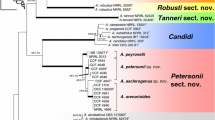Abstract
From an undisturbed natural forest soil in Ecuador, three fungal strains of the genus Aspergillus were isolated. Based on molecular and morphological features they are described as three new species, named A. quitensis, A. amazonicus, and A. ecuadorensis.












Similar content being viewed by others
References
Balajee SA, Houbraken J, Verweij PE, Hong S-B, Yaghuchi T, Varga J, Samson RA (2007). Aspergillus species identification in the clinical setting. Stud Mycol 59:39–46
Fantin F, Giovannini PP, Guerrini A, Maietti S, Medici A, Pedrini P (2006) Enantioselective Baeyer-Villiger oxidation of bicycle[3.2.0]hept-2-en-6-one with fungi: optimization of biotransformation and use of TiO2 as support of cell growth. Biotechnol Lett 28:805–810
Griffin DW, Kellogg CA, Peak KK, Shinn EA (2002) A rapid and efficient assay for extracting DNA from fungi. Lett Appl Microbiol 34:210–214
Hawksworth D, Kirk P, Sutton B, Pegler D (1996) Ainsworth’s and Bisby’s dictionary of the fungi, 8th edn. CABI, Wallingford, UK
Mares D, Romagnoli C, Benvegnù R et al (2002). Mannan-mediated antifungal activity on Epidermophyton floccosum by 3-methyl-5-aminoisoxazole-4-thiocyanate, a new azole derivative. Fung Gen Biol 36:47–57
Munsell (1990) Munsell soil color charts. MacBeth Division, Kollmorgen Instruments Corp. Baltimore, MD
Newton RF (1982) In: Roberts SM, Scheimann F (eds) New synthetic routes to prostaglandins and thromboxanes. Academic Press, New York, p 61
Raper KB, Fennell DI (1965). The genus Aspergillus. Williams and Wilkins, Baltimore, MD
Samson RA, Hong SB, Frisvad JC (2006) Old and new concepts of species differentiation in Aspergillus. Med Mycol 44:S133–S148
Samson RA, Varga J, Witiak SM, Geiser DM (2007) The species concept in Aspergillus: recommendations of an international panel. Stud Mycol 59:71–73
Taylor JW, Jacobson DJ, Kroken S Kasuga et al (2000) Phylogenetic species recognition and species concepts in fungi. Fung Gen Biol 31:21–32
White TJ, Bruns T, Lee S, Taylor J (1990) Amplification and direct sequencing of fungal ribosomal RNA genes for phylogenetics. In: Innis M, Gelfand D, Sninsky J, White T (eds) PCR protocols: a guide to methods and application. Academic Press, San Diego, CA, pp 315–322
Acknowledgments
The authors wish to thank Prof. Marisa Ferraresi, Dr. Mirco Iotti, and the staff of the Electron Microscopy Center at Ferrara University for their skillful assistance. This work was supported by research grants from MIUR-URST (Ministero dell’Istruzione, dell’Università e della Ricerca-Area Università e Ricerca Scientifica e Tecnologica) of Italy.
Author information
Authors and Affiliations
Corresponding author
Rights and permissions
About this article
Cite this article
Mares, D., Andreotti, E., Maldonado, M.E. et al. Three New Species of Aspergillus from Amazonian Forest Soil (Ecuador). Curr Microbiol 57, 222–229 (2008). https://doi.org/10.1007/s00284-008-9178-9
Received:
Accepted:
Published:
Issue Date:
DOI: https://doi.org/10.1007/s00284-008-9178-9




